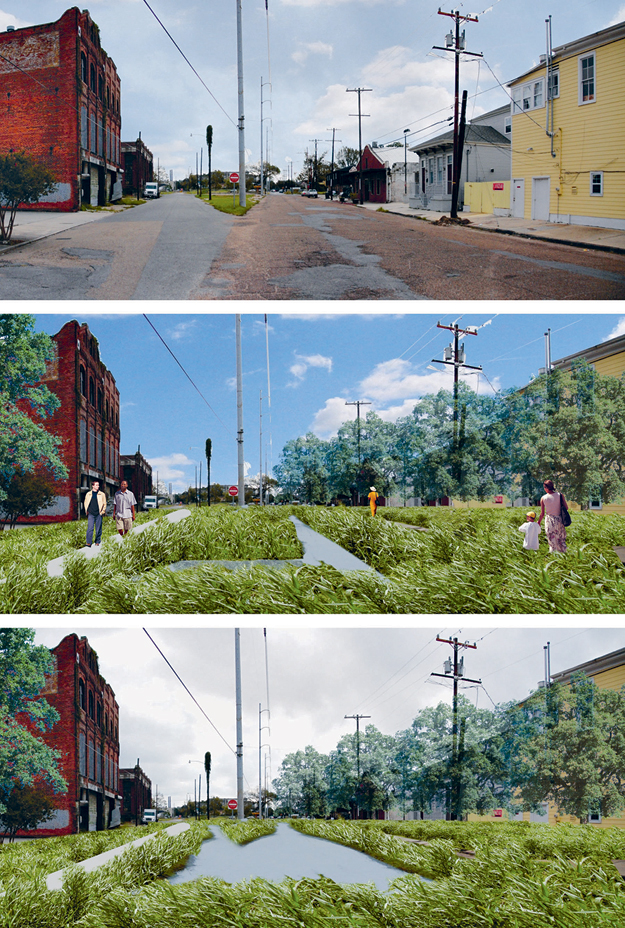Can the Good Times Roll After the Flood Waters Recede?
 |
| Images courtesy Waggonner & Ball |
| Architects at Waggonner & Ball devised plans for the Hoffman Triangle area that change its current state (top) into one that accommodates various water-storage options (above). |

The subtitle here is a bit of a spoiler. News flash: equitable, sound, socially responsible planning did not happen in post-Katrina New Orleans. This won't shock anyone who watched HBO's Treme on a regular basis. But that's the message conveyed by the book's editors right at the outset, in their lively, polemical introduction. Fortunately, their rueful pessimism tells an incomplete and still-evolving story, as they will be the first to concede. New Orleans, nine years after the flood, remains a work in progress.
In the immediate aftermath of the storm, it seemed as if the entire world of architecture and planning had descended on the besieged city. Exactly who and what they would design and plan for was uncertain at that point. There was a feeble, corrupt (as it later turned out) mayor ostensibly in charge, along with an almost tragic lack of government leadership, and no clear lines of author-ity. The design schools arrived soon after, working on a parallel track, armed with foundation grants, good but often misguided intentions, and the willful naivet' typical of architecture and planning students (and their professors).
As recounted by essays early in the book, the official planning process got off to a bumpy start in January 2006, with the Bring New Orleans Back commission, which recommended shrinking the city's footprint and not redeveloping six low-lying neighborhoods. The communities slated for elimination (the infamous green dots) took vocal exception, and the plan died a quick death. Two other major planning efforts were launched, while the real power brokers pushed a different redevelopment agenda: the abandonment of Charity Hospital (in favor of a mammoth suburban-style replacement near the French Quarter), the dismantling of the public schools in favor of a charter system, and the unnecessary demolition of much of the city's public housing. Eventually these initiatives became official policy.
Meanwhile, in the absence of municipal leadership, something more promising began unfolding in the neighborhoods. "What was amazing about the UNOP [Unified New Orleans Plan] process was the phenomenal level of grassroots engagement," writes Derek James Hoeferlin in his essay on the rebuilding. "The real work happened-and succeeded-at the neighborhood and district level." Broadmoor, a racially and economically diverse neighborhood, was particularly well organized, spearheading efforts to save its own branch library and build an award-winning addition, designed by Eskew Dumez + Ripple.
The book-a huge doorstop that might have been considerably improved with judicious pruning-tells that messy, complicated story. It includes solid essays by Denise Scott Brown, Naomi Klein, Rebecca Solnit, and Melissa Harris-Perry and William M. Harris, as well as interviews with notable local players, including the architects David Waggonner and the late Allen Eskew, and a particularly cogent and clear-eyed assessment of things by community activist Jeanne P. Nathan. Providing a kind of academic snapshot of Katrina-as-learning-experience, it also includes dozens of largely unrealized design projects by leading practitioners and students. Taken together, the book is fragmentary and something of a free-for-all, but should provide an indispensable roadmap for future historians, and is fascinating in that regard. As a reading experience, however, it's a mixed bag, elegant and engaging in some places, lumpy and academic in others.
And yet despite the book's all-too-accurate subtitle, the city is in the midst of a continuing renaissance. It's an uneven revival, as is typical of the Crescent City, but the energy here remains real and palpable. The music and food scenes, in particular, have come roaring back. This raises an uncomfortable question for planners: did the rebirth of New Orleans happen in spite of them? Does "official" planning even matter? For its part, the book offers up some consolation, featuring a smattering of real-world projects, modest victories, that are all small-scale and community-based. It was here in the neighborhoods where the authentic seeds for renewal were planted. As it turns out, top-down planning did, in fact, fail New Orleans, but citizen activists surely saved it.
Martin C. Pedersen, former executive editor of Metropolis, is a writer and editor living in New Orleans.

Post a comment to this article
Report Abusive Comment